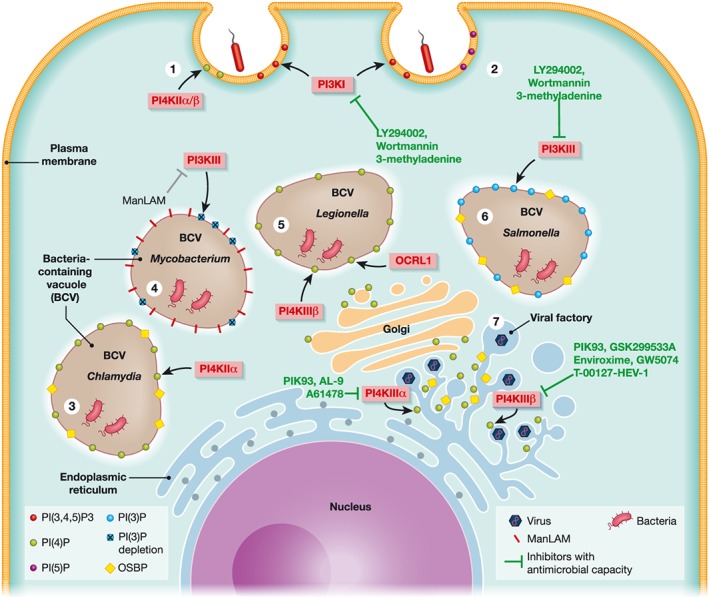Figure 2.

Schematic summary of phosphatidylinositol (PI)‐derived signalling pathways triggered by bacteria and viruses. Compounds that interfere with these pathways and have antiviral or antibiotic activity are indicated. (1) Listeria uses the InIB effector, which engages with host receptor Met and stimulates the recruitment of PI3KI to the bacterial entry sites. PI3K activation produces PI(3,4,5)P3, resulting in the reorganisation of cytoskeleton favouring the entry of Listeria. Both Listeria and Chlamydia additionally recruit PI4KIIα/β to the plasma membrane, where it produces PI(4)P also promoting uptake. (2) Brucella and Salmonella require PI3KI recruitment and activity for entering the cell. Alternately, Anaplasma phagocytophilum and Shigella need the subsequent PI3K–AKT pathway to delay apoptosis. Moreover, Shigella's entry site requires an enrichment of PI(5)P stimulated by IpgD. (3) After entry, Chlamydia recruits PI4KIIα to the inclusion, generating PI(4)P and leading to the recruitment of the lipid transfer protein oxysterol‐binding protein (OSBP). (4) Mycobacterium produces the mannose‐capped lipoarabinomannan (ManLAM) to interfere with PI3KIII activity. Disruption of PI3KIII reduces the amounts of PI(3)P on the inclusion surface and avoids phagosomal maturation. (5) Recruitment of PI4KIIIβ and OCRL1 together with the hijacking of the secretory pathway enriches Legionella inclusion in PI(4)P. (6) The Salmonella effector SopB recruits PI3KIII to the inclusion surface to maintain high levels of PI(3)P. The SseL effector binds to OSBP, which is recruited to the inclusion periphery. (7) Many different viruses recruit and exploit host PI4KIII kinases to build viral factories within reorganised cell membranes. Hepatitis C virus and encephalomyocarditis virus remodel endoplasmic reticulum membranes to build replication organelles with the assistance of PI4KIIIα that generates PI(4)P at the replication sites. In a similar manner, PI4KIIIβ is used by other viruses such as picornaviruses, enteroviruses, Coxsackievirus B3, and human rhinoviruses
